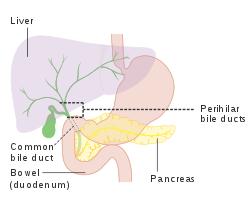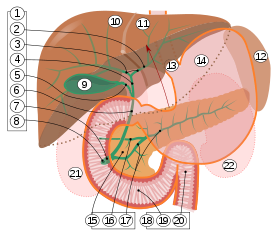
Back القناة الصفراوية المشتركة Arabic Glavni žučovod BS Colèdoc Catalan Hlavní žlučovod Czech Ductus choledochus German Koledoko Esperanto Conducto colédoco Spanish Behazun-hodi komun Basque مجرای صفراوی مشترک Persian Conduit cholédoque French
| Common bile duct | |
|---|---|
 Diagram of the biliary tree showing the common bile duct | |
| Details | |
| Part of | Biliary tract |
| Identifiers | |
| Latin | ductus choledochus,[1] ductus biliaris[1] |
| Acronym(s) | CBD[2] |
| MeSH | D003135 |
| TA98 | A05.8.02.013 |
| TA2 | 3103 |
| FMA | 14667 |
| Anatomical terminology | |

2. Intrahepatic bile ducts
3. Left and right hepatic ducts
4. Common hepatic duct
5. Cystic duct
6. Common bile duct
7. Ampulla of Vater
8. Major duodenal papilla
9. Gallbladder
10–11. Right and left lobes of liver
12. Spleen
13. Esophagus
14. Stomach
15. Pancreas:
16. Accessory pancreatic duct
17. Pancreatic duct
18. Small intestine:
19. Duodenum
20. Jejunum
21–22. Right and left kidneys
The front border of the liver has been lifted up (brown arrow).[3]
The bile duct[1][4] (formerly known as the common bile duct[4]) is a part of the biliary tract.[4] It is formed by the union of the common hepatic duct and cystic duct. It ends by uniting with the pancreatic duct to form the hepatopancreatic ampulla. It possesses its sphincter to enable the regulation of bile flow.
- ^ a b c "Anatonomina". terminologia-anatomica.org. Retrieved 2023-07-07.
- ^ Agabegi, Steven S.; Agabegi, Elizabeth D. (23 August 2012). Step-Up to Medicine. Lippincott Williams & Wilkins. p. 136. ISBN 9781609133603.
- ^ Standring S, Borley NR, eds. (2008). Gray's anatomy : the anatomical basis of clinical practice. Brown JL, Moore LA (40th ed.). London: Churchill Livingstone. pp. 1163, 1177, 1185–6. ISBN 978-0-8089-2371-8.
- ^ a b c Sinnatamby, Chummy S. (2011). Last's Anatomy (12th ed.). pp. 263–266. ISBN 978-0-7295-3752-0.